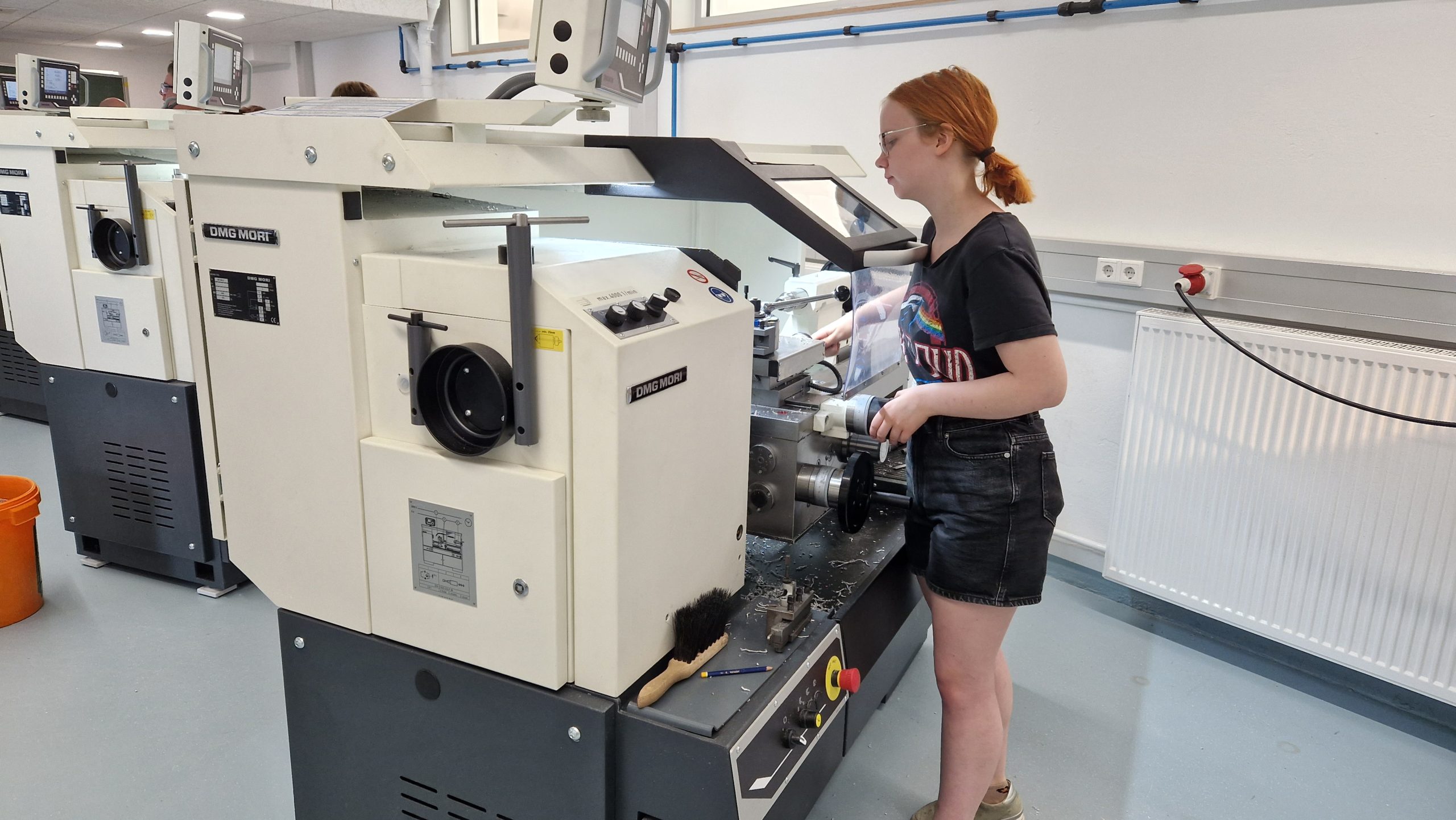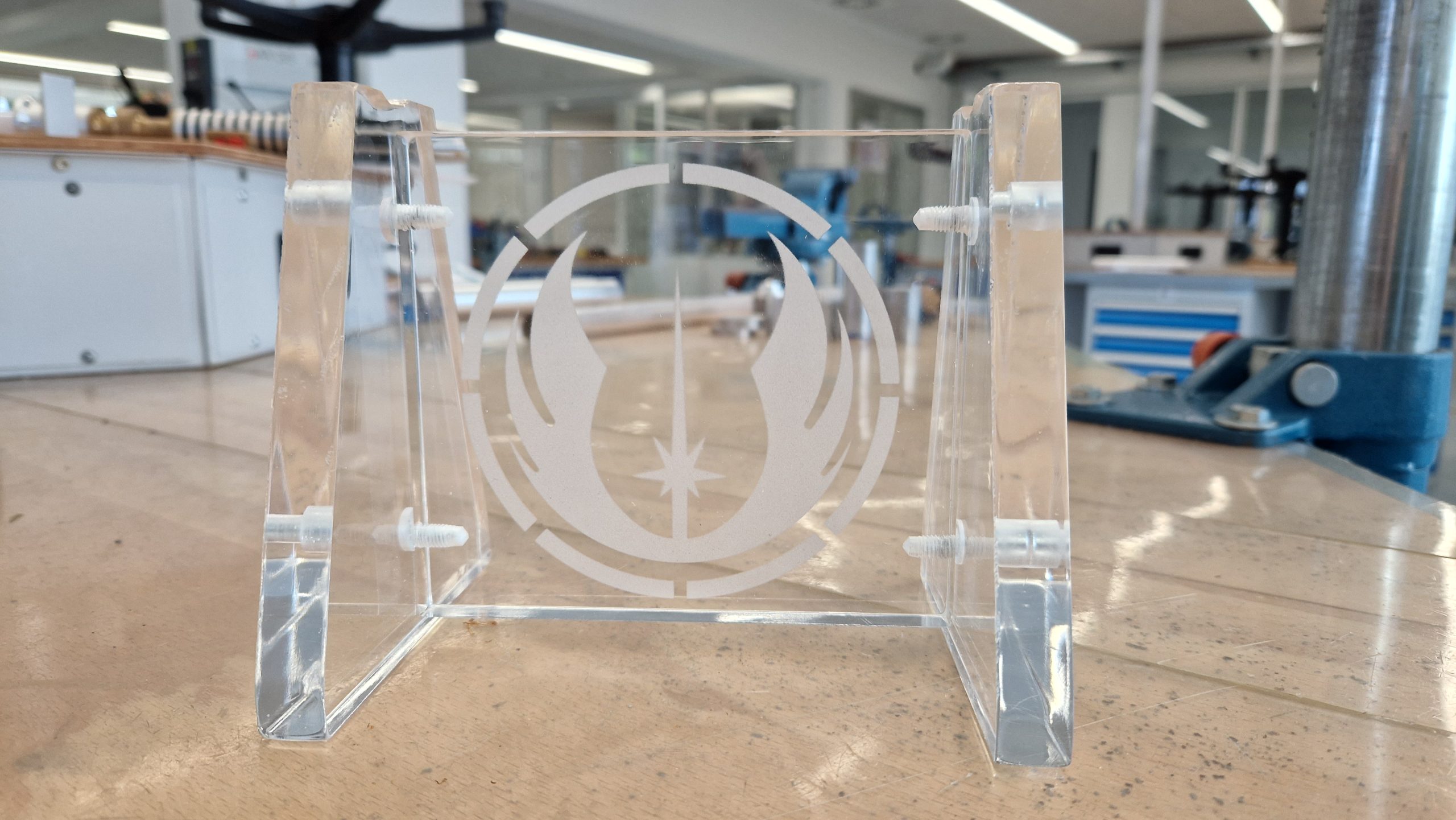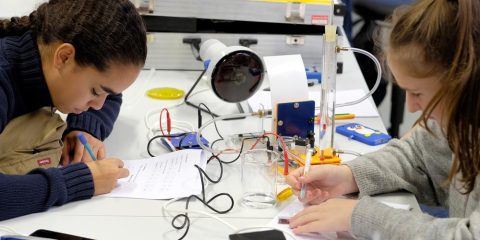This year's summer holidays finally offer children and young people the opportunity to exchange ideas with other MINT enthusiasts. In the zdi holiday courses you can discover a wide range, which often revolves around a topic in particular: RE•use | RE•duce | RE•cycle – make new from old Sustainability plays a major role in the lives of many young people, as the report explains "Under the magnifying glass: youth trends when choosing a career" can read. How is the enthusiasm for sustainability issues reflected in the holiday courses? How can current scientific trends in areas such as wind power be implemented in courses that students can understand? And how do art and design find their way into STEM education? In the zdi holiday summer 2022 series, we would like to go into more detail.
SciFi meets MINT: light saber construction in the zdi center Lippe-MINT
Premiere in Cologne: Pupils build designer lamps from scrap
MINT holidays: future worlds in Espelkamp
SciFi meets STEM: light saber construction at zdi center Lippe.MINT
What influence does science fiction have on today's science? How can she get young people excited about STEM? And how does real science find its way into fictional science? Searching for clues during the holiday course "Build your own lightsaber“ in the zdi center Lippe.MINT
At the beginning of August it is already quite warm outside in the morning, but it is pleasantly cool in the metal workshops of the Lüttfeld vocational college in Lemgo. And not only that: Considering that there are three groups of students here, it is also incredibly quiet, because everyone is engrossed in their tasks: Some work blocks of acrylic with sandpaper, others solder fine wires, the third The group receives an introduction to the milling machines in the adjoining room. What looks like a basic course in apprenticeships such as electrical engineering, cutting machine operator or electronics technician is actually a career-oriented holiday course: the course participants should follow in the footsteps of their science fiction heroes and create their own lightsaber - not just that crystals and power, but with metal and MINT!
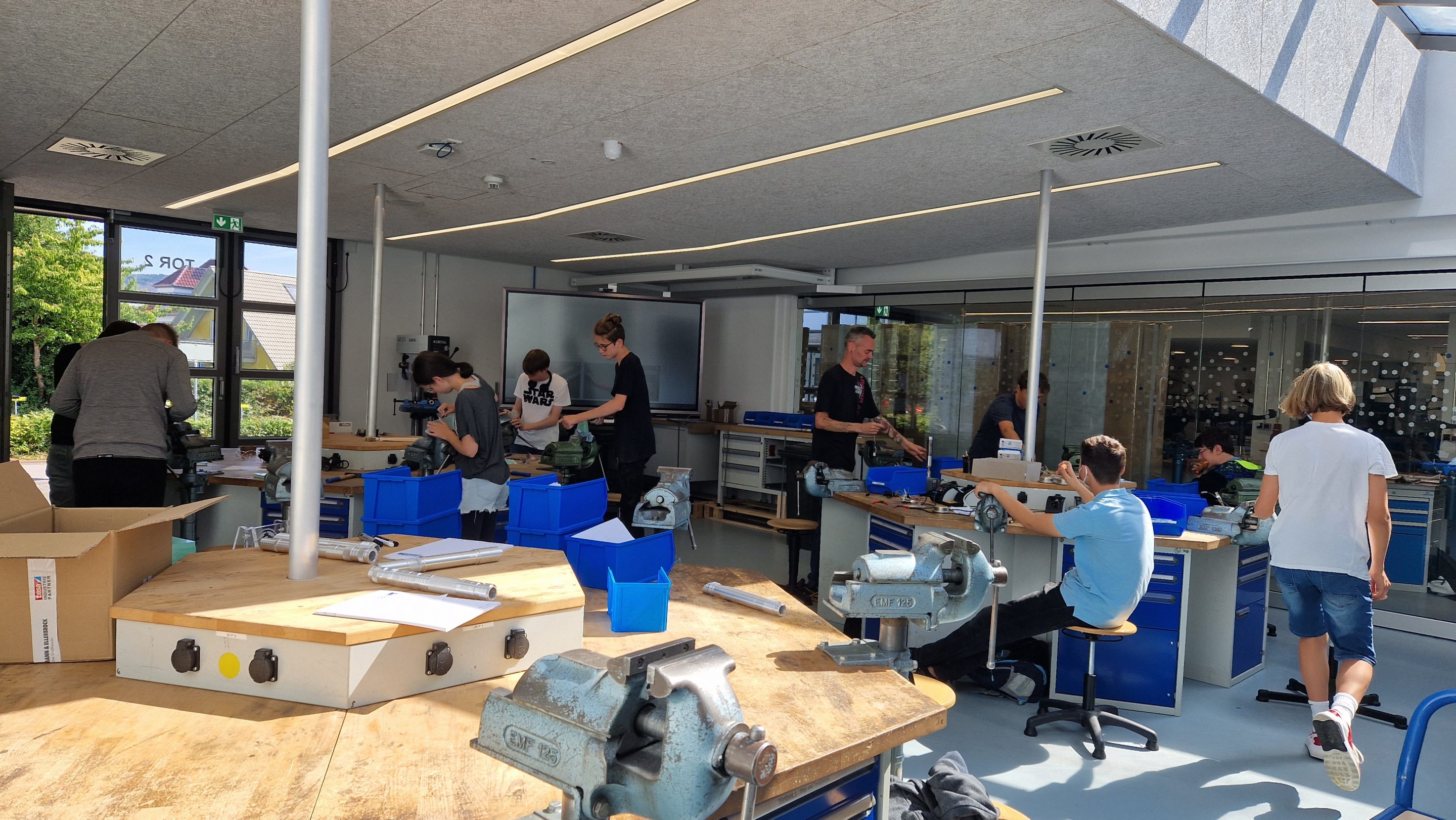
“I'm pleased to see how enthusiastic the young people are about this. This course shows wonderfully how well MINT topics and science fiction can be combined and how enthusiasm for MINT can be created in this way," says Georg Mertens from the Ministry of Culture and Science of the State of North Rhine-Westphalia, which together with of the NRW Regional Directorate of the Federal Employment Agency makes the course possible via the zdi-BSO-MINT funding program. This means that young people can take part in the course free of charge.
From fiction to reality
Lightsabers already had a symbolic character in Star Wars. They should bring an air of honor to the Jedi Knights, for they are "Not as clumsy and as inaccurate as firearms. An elegant weapon from civilized days.” That's what Obi-Wan Kenobi calls the lightsaber he hands over to Luke Skywalker in Episode IV: A New Hope. The way the lightsaber is carried and wielded, how it feels in the hand and what is connected to the sword is correspondingly important. So the question "What would a 'real' lightsaber blade be made of?" seems to have less meaning than the question "How do I make my lightsaber unique?". Initially, an emotional aspect is in the foreground, which should facilitate access to practical knowledge.
Carsten Kießler is also aware of this effect. Kießler, head of the zdi center Lippe.MINT, remembers how the course came about: “The idea for the course came from my private passion for Star Wars, but also from the idea that you need a good learning medium in order to sustainably transfer knowledge to be able to mediate. With us, this learning medium is the lightsaber. And then you have to think: How can I implement a topic that interests young people in vocational training? Which job descriptions can I depict and how?” Together with the “lightsaber learning medium”, the knowledge acquired about production – from technical product design to machining production and electronics to plastics processing – would be much more likely to be taken home with you. "We also use the method behind this idea very successfully in other projects, for example in the area of 3D printing," says Kießler.
The success of the method could be a reason why several zdi networks were able to offer courses on the subject of Star Wars in 2022: The Star Warrior workshops in the zdi center Mönchengladbach or the zdi network district of Coesfeld were able to inspire the participants with lightsaber construction and costume design for manual and technical topics. The zdi center Lippe.MINT has been offering the course since 2018 and is a pioneer in a lively exchange with other actors in the NRW-wide zdi community. Georg Mertens is convinced: "The 'Build your lightsaber' course is a good example of the advantages zdi.NRW offers: The zdi networks can learn from each other and exchange their wealth of experience."
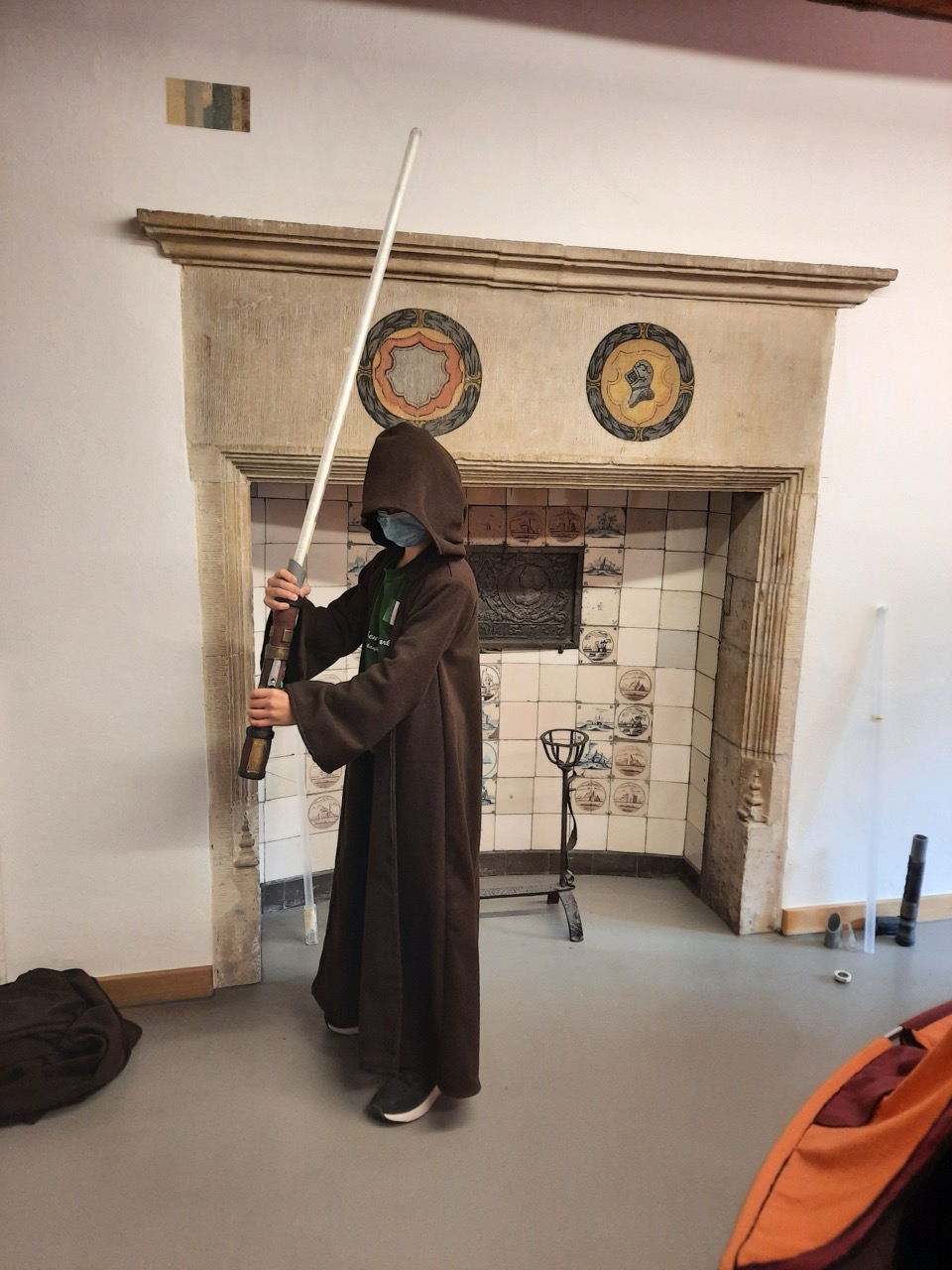
In addition to a good learning medium and an exciting topic, the pedagogical concept must also be right, as media educator Kai Lenski knows. For eight years he has been making lightsabers as individual commissions in his "first Saberstore in Germany“ and was involved in the conception of the course from the very beginning. So that there is no conflict between expectations and reality, the course concept is adapted to the participants and there are always enough supervisors on site to be able to provide appropriate support. “Some young people only realize how much work they have to put into the lightsaber during the course. Here we patiently guide so that in the end everyone gets exactly the lightsaber they had in mind,” says Lenski. A good quality of the lightsabers is also important in order to be able to embody the symbolic character that was so important to Obi-Wan Kenobi: "That's why our lightsabers are not just made of plastic, but solid, stable and valuable."
The science behind lightsabers
Lightsabers aren't just something for the 15 Padawans attending the zdi course in Lemgo. Researchers from a wide range of disciplines are questioning how the Jedi Knights' luminous combat devices work. And has been since 1977 when the first Star Wars film flickered across cinema screens. Prof. Carsten Welsch from the University of Liverpool uses Star Wars to point out current developments in science: For example, laser surgery, in which lasers are used instead of a scalpel to cut through or remove tissue, and which - in contrast to lightsabers - in 2022 is no longer fiction for a long time.
However, a consensus among scientists seems to be that the blades of the lightsabers cannot be made of light or lasers. According to a theory shared by Prof. Carsten Welsch, the blades could be made of plasma. The particle mixture of free charge carriers is also referred to as the "fourth state of aggregation" and on the one hand gives off a lot of heat, on the other hand it can be shaped by an electromagnetic field - both properties that the lightsabers in the film have.
Luke Willcocks, a student at the University of Leicester at the time, calculated the immense power that could be contained in a lightsaber[I]: In a thought experiment, he determined the power of a lightsaber based on the speed at which the weapon can cut a hole in a metal door. According to this calculation, the lightsaber has an impressive 6,96 megawatts – which roughly corresponds to the nominal output of a wind turbine.
The lightsabers that are to be built in Lemgo do not contain around seven megawatts, but the technology behind them is always state-of-the-art. “There is a large market for lightsabers, especially in the USA. The technology used there is also constantly being further developed, for example the soundboards used. We use individual LEDs here in the course to make the sword light up. However, you can also use LED strips, so you can even adjust the extension of the illuminated blade,” reports Kai Lenski enthusiastically.
How fiction and reality influence each other
That the success of Star Wars-Franchise contributes to the success of the zdi course, no one doubts the organizers and the participants. The thrill of holding your own lightsaber in your hands was the biggest motivation for the young people in grades seven to eleven to register for the course. However, there was also a basic joy in manual work for most of them.
surveys[ii] among students and teachers have already shown that science fiction - and above all the Star Wars franchise - can have an effect on the perception of science. But not only the perception of science is influenced, scientists themselves are inspired by the visions of science fiction authors.
A 2018 study conducted by the University of Hawaii[iii] was able to show that science fiction plays an inspiring role, at least in the research area of human-technology interaction. The number of scientific publications relating to science fiction increased steadily between 1982 and 2017 and even increased almost tenfold.
Science fiction has inspired science for centuries
When you think of submarines, you think of Jule Verne's "20.000 Leagues Under the Sea" and his Nautilus, after which, among other things, the first nuclear submarine was named. However, the first submarines appeared much earlier: in 1666 Margaret Cavendish, Duchess of Newcastle, published "The Glistening World". The work is now regarded as a forerunner of science fiction and describes a utopian world in which the submarines are more reminiscent of carriages.

HG Wells' 1898 book "War of the Worlds" motivated Robert Goddard to study physics. The rocket engines he developed made modern space travel possible in the first place.
Green and sustainable urban development was already a topic in the short story "Sultana's Dream" by the Bengali writer Rokeya Sakhawat Hussain, published in 1905: In the utopian, feminist "Ladyland", all devices run on solar power, asphalt has been replaced by green areas and water is obtained directly from the atmosphere – not to mention flying electric cars.

As early as 1964, the science fiction author and physicist Arthur C. Clarke gave a very precise description of our modern networked society in a BBC interview.
Science fiction can be less about how technology works and more about what it does to us and how it affects our lives. This idea is also adopted by the method of science fiction prototyping. The methods of science fiction authors are used to create new product ideas or to further develop entire companies and their structures. A rather emotional rather than a technical approach is created. This makes the technology accessible to a broader mass of people. If a first interest is aroused, this can be deepened on a more technical level. For example when building a lightsaber!
[I] Willcocks, Luke. (2017). Calculating The Power Output of Qui-Gon Jin's Lightsaber. Journal of Interdisciplinary Science Topics. 6. (Retrieved 19.07.2022-XNUMX-XNUMX)
[ii] Petit, M.F. & Solbes, Jordi. (2012). Science fiction and the teaching of science. Ensenanza de las Ciencias. 30. 55-72. 10.5565/rev/ec/v30n2.494.(Retrieved 20.07.2022-XNUMX-XNUMX)
[iii] Jordan, Philipp & Mubin, Omar & Obaid, Mohammad & Silva, Paula Alexandra. (2018). Exploring the Referral and Usage of Science Fiction in HCI Literature. (Retrieved 14.07.2022-XNUMX-XNUMX)
Premiere in Cologne: Pupils build designer lamps from scrap
For the first time, the zdi center in Cologne organized the summer holiday course “Handcraft meets art: upcycling lamps”. In the Sculpture Cologne 8 students designed and built their own lamp. The special feature: they used "rubbish" to build the lamps. According to this year's zdi motto: Make new from old!


Photos: Katrin Kleinau, sculpture workshop in Cologne
Exciting mix of craftsmanship, design, recycling and technology
When the five girls and three boys from grades 7 to 11 arrived at the sculpture workshop on the first day of the course, a large table full of scrap was already waiting for them: finds from the hardware store or flea market, parts from the yellow bin or from the scrap yard. From this they chose parts that they wanted to use for their lamp project. And over the next five days, the students used it to design their own upcycling lamp.
They were accompanied by two lecturers from the sculpture workshop in Cologne. They gave them basic knowledge about shapes and design, the medium of light as an object, and electrical and lighting engineering. They also instructed the young people individually in handling different materials such as wood, plastic or metal.
And along the way, the young people learned a lot about sustainability. What other uses can waste have and how can it be recycled?
At the end of the course, the students presented their lamps at a vernissage. Family and friends were also invited.
Artists promote creativity and sustainability
In the craftsmen's and artists' studio in Cologne, the ambience alone invites you to get creative. Everywhere one sees art objects and tools, it smells of wood and paint. Two artists from the studio led the holiday course: Eik Niemann, carpenter, craftsman and all-rounder and Katrin Kleinau, qualified artist and sculptor.
"I particularly enjoy raising awareness of dealing with forms, materials and surfaces of found objects from an aesthetic point of view," says Katrin Kleinau. She wants to encourage the desire to creatively recreate garbage and take an appreciative look at it. "Because the scrap we've been working with for the past five days is originally made from valuable fossil materials," she adds.
Eik Niemann also looks back optimistically on the five days with the students: "I hope that we were able to use the implementation to show, both technically and artistically, what else scrap can be used for and that we will open the horizons of the young people even further could."
A very special course that calls for repetition
Sandra Grinblats from zdi center in Cologne is so enthusiastic about this holiday course that she would definitely like to offer it again. “The course was exceptional; individual, tactile, practical and creative,” she describes enthusiastically. "It was just great to see what great objects can be made from rubbish."
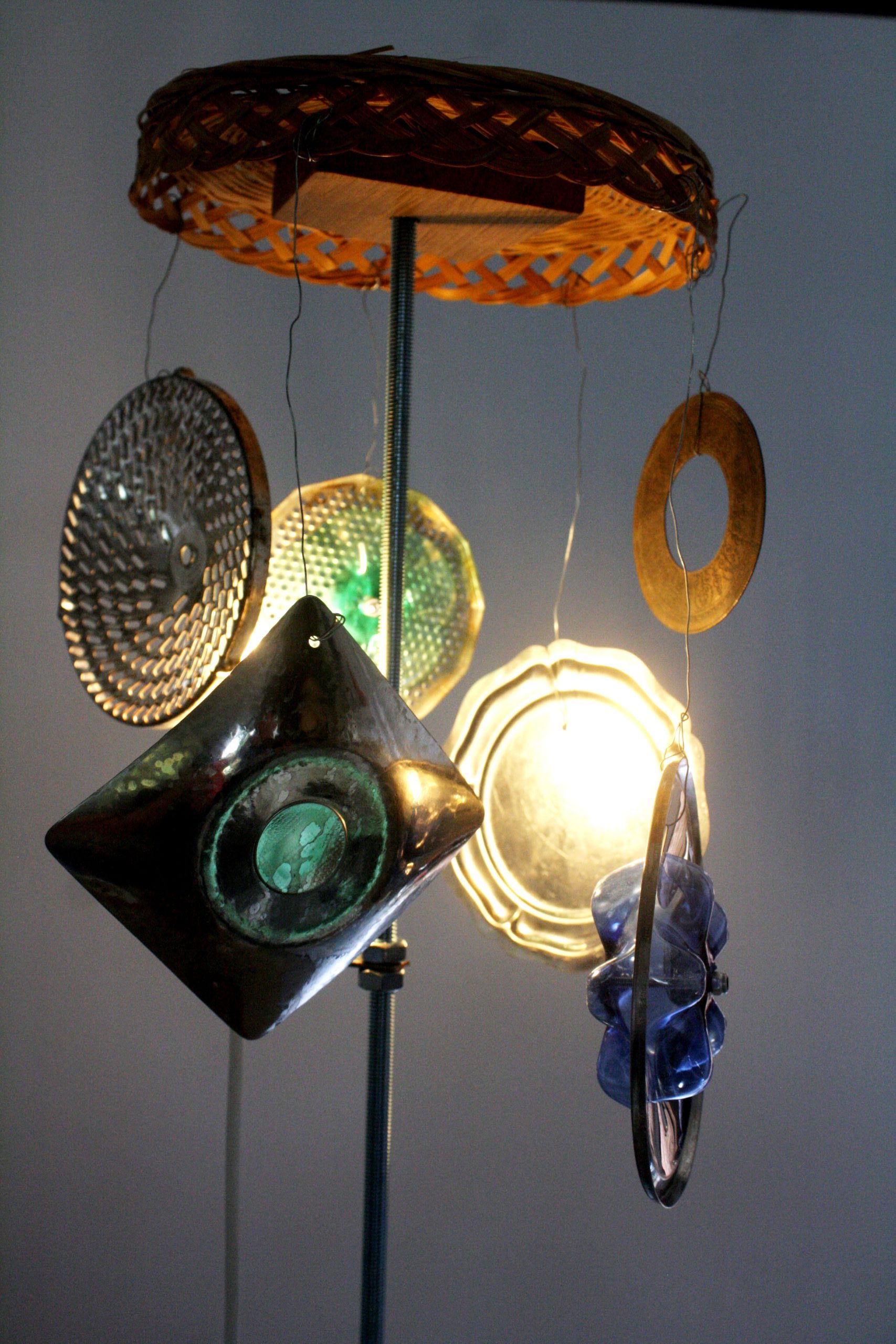

The personal effect on the young people is also particularly worth mentioning. You could see how the creative process and the self-designed object did their self-esteem good.
The student Viktoria Schurig also confirms this. "I love tinkering and building at home... and when the new newsletter came out and my parents read it to me, "HANDWERK MELTIFFT KUNST" spoke to me directly! So I signed up right away. The course was just BEAUTIFUL and a lot of fun! I didn't think that we would build such great lamps and that time flies so quickly. One day was really crazy: felt almost NOTHING DONE AT ALL, but the whole time was MEGA busy with drilling, filing, cutting...
Thank you very much for letting me be there!!!”, the student thanked the organizers in an email.
MINT holidays: future worlds in Espelkamp
"Your + MINT = future", this equation went into the MINT holidays in Espelkamp on. For a whole week, children and young people were able to research, experiment and deal with current MINT topics at two event locations. Some were able to discover MINT topics for themselves in a completely new way, others were "repeat offenders" and had already taken part in several MINT courses at the zdi center. They had one thing in common: a passion for STEM!

You can hear the enthusiasm in the voice of Stefan Kiel, who is responsible for the project on the part of the zdi center Minden-Lübbecke, be careful when he talks about the holiday course: “There were fewer registrations this year, which is understandable. After all, many families use the school holidays for the long-awaited vacation. Those who take part in our courses are all the more motivated and interested and take part very actively. That is great fun for everyone involved.”
The fun of the thing is immediately noticeable to the participants: inside the MINT holidays, when they don’t let themselves be lured away by the wind turbine construction kits even during the scheduled break. Sustainable energy in the form of wind power is on the agenda today, Friday. Experiments can be carried out on a wind turbine model that you have assembled yourself: How much energy does the wind turbine generate? And what kind of rotors are best for generating energy? The children and young people can put the results of their experiments directly into practice and build rotors for their windmill; with the best properties in length, width, inclination and number.
Meet different needs
“Usually our courses are two hours long, today it will be five hours. But that's not a problem with this group, because everyone is very motivated and committed - and so everyone can take as much time as necessary," says student teacher Eduard Schmidt happily, while his colleague Jakob Hübler is completely from a group children and explains the formulas with angelic patience. Schmidt recently joined the group of students at the University of Paderborn who are studying there Pupils: indoor laboratory and also supervise courses like this. The needs and demands of the participants are very different. Because while some are setting up formulas for calculating performance, others are still busy with the assembly instructions.
The course module on energy conversion in wind turbines was developed by students at the University of Paderborn and is also carried out by them. From the point of view of the two student teachers, the opportunity to work with children and young people at an extracurricular learning location offers a number of advantages. Jakob Hübler in particular, who is studying the combination of subjects chemistry and physical education, is pleased with the more technical and mathematical input of the courses and the new insights that he gains from them: the practical approaches that students use at extracurricular learning locations for MINT topics can be inspired, offer fresh ideas for the lesson design. It is also very pleasant to work with children who want to spend their free time voluntarily with MINT and are accordingly motivated.
The University of Paderborn and the Heinz Nixdorf MuseumsForum jointly operate the “coolMINT.paderborn school lab”. The school laboratory is part of the project STEM community 4.OWL, which also includes a total of six zdi centers. The project is funded by the Federal Ministry of Education and Research.
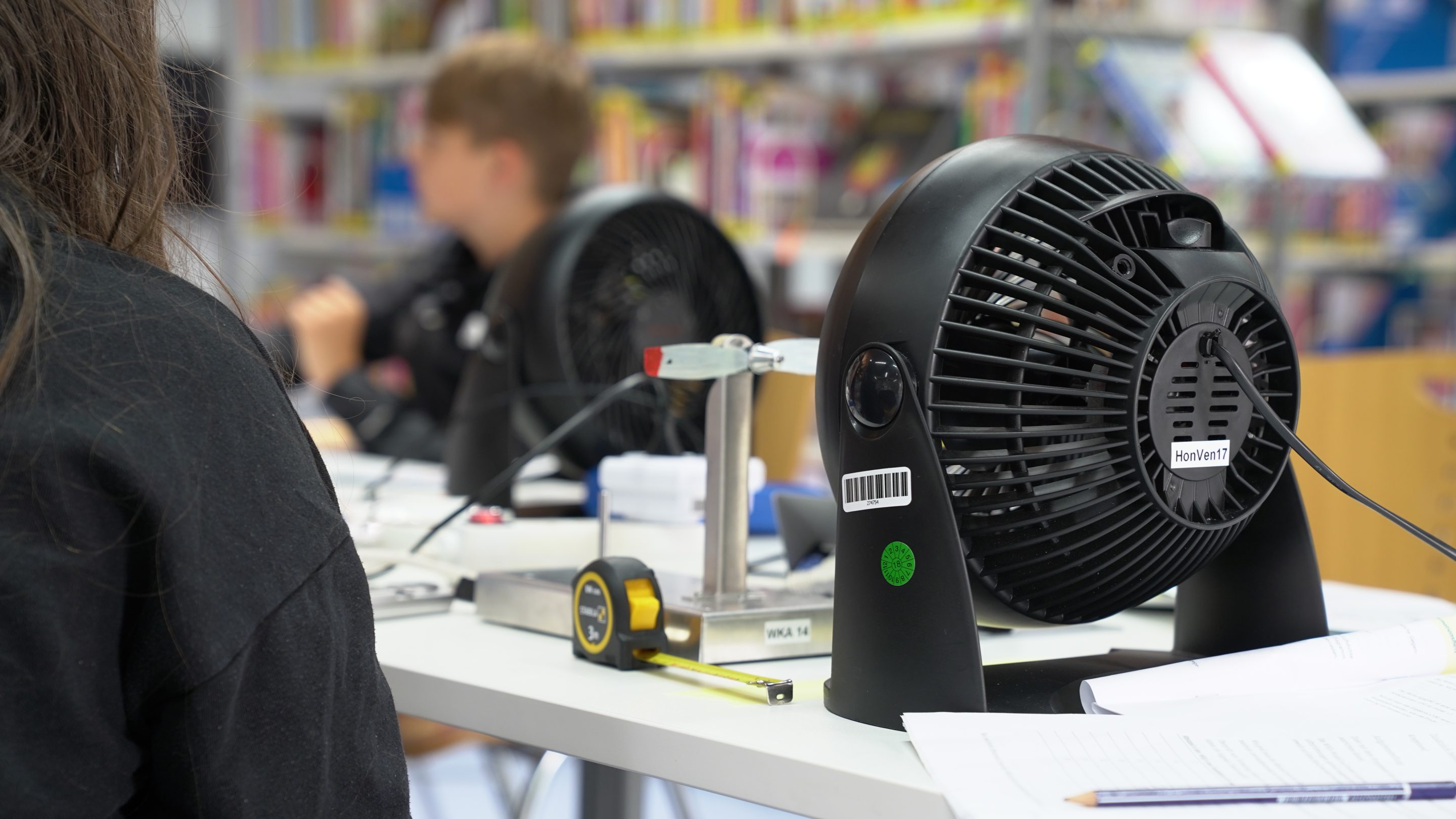
The topic of sustainability is of great importance both in the development of the course modules by the University of Paderborn and in the planning of events by the zdi center Minden-Lübbecke: "Incorporating regenerative and sustainable topics into our program is a duty for us," says Stephen Kiel. In addition to the module on wind energy, computer science and robotics were also on the program during the MINT holiday week: the robots that were used from Tuesday to Thursday were particularly well received.
On Monday, the "Make Light" module was on the agenda, which is also offered by the University of Paderborn. The participants had a lasting memory of programming with Arduino boards. The adaptability to the various needs of the participants was again evident in the entire program of the MINT holidays: They could program projects of varying complexity or work with color blocks instead of a text-based programming language.
Library and zdi center: A promising partnership
In addition to the Isy7 youth center, three days of the holiday week were held City Library Espelkamp Venue for the MINT holidays. Karin Wewers, who is responsible for public relations at the city library, explains how the collaboration with the zdi center came about: “Two years ago we set up a 'Library of Things'. You can easily borrow robotics technology from us. However, there is often a lack of educational support, which we cannot provide to the extent from the library alone. The zdi center in Minden-Lübbecke was therefore recommended to us as a competent partner, who have been at our side since then with professional support and also with the implementation of the content of the events. The cooperation works wonderfully, the competencies complement each other very well. This is also reflected in the smooth running of the courses.”

Karin Wewers sees another advantage in the fact that the participants can get to know the “Library of Things” directly in the library and at the same time learn in the courses how to handle the objects correctly. This makes it easier to borrow, because the course allows you to prove that you are able to handle robots and the like properly. However, no previous knowledge is required to rent the MakerBoxes, which the library also offers. Karin Wewers knows: “The robots in particular are quite expensive. Before parents are willing to spend so much money, it can help to try out a robot from us first and maybe even borrow it. In this way, access to technology is made possible for a much broader spectrum of people.”
The cooperation between the city library and the zdi center is perceived by both sides as an absolute "win-win" situation and should definitely be continued in the future. Libraries are ideal partners for zdi networks, especially in rural areas and in large regions. They can be found in most cities, resulting in a large network of venues. In addition, libraries are often equipped with high-quality technical equipment, which, however, is not used as much as it could be due to a lack of staff. Here, zdi networks can help out with expert staff and use the existing technology and the location advantage. “Especially during the holidays, the youth centers are often fully booked and are not available as venues for our MINT holiday courses. The city library offers an excellent alternative here,” confirms Stefan Kiel.
"We are pleased that we can create offers in which a wide variety of actors in the region can come together and contribute. The various offers complement each other in a meaningful way and thus meet the needs of our target groups,” summarizes Carmen Ruffer, zdi coordinator of the zdi center Minden-Lübbecke. The organizers are already looking towards the autumn holidays, in which joint projects are to be implemented again.

